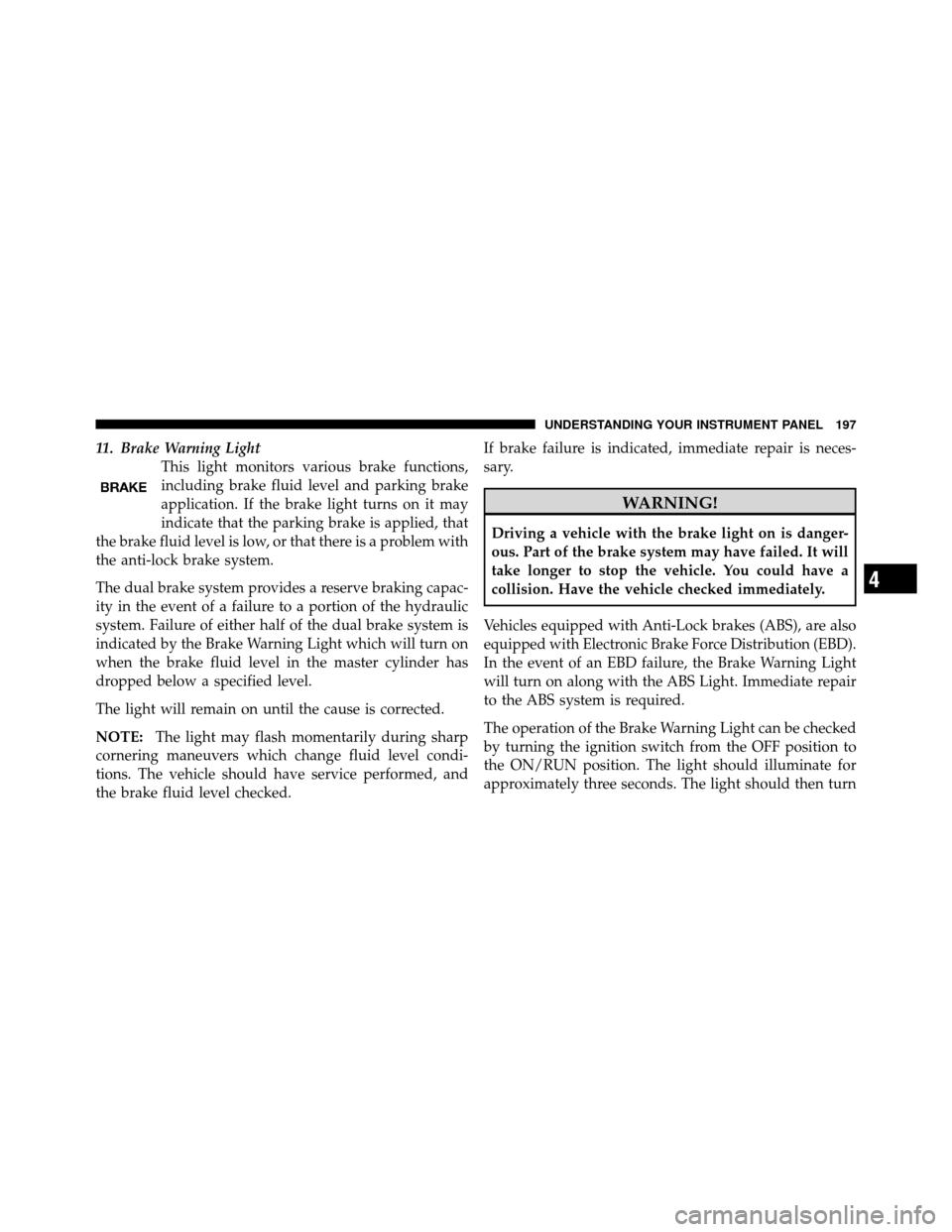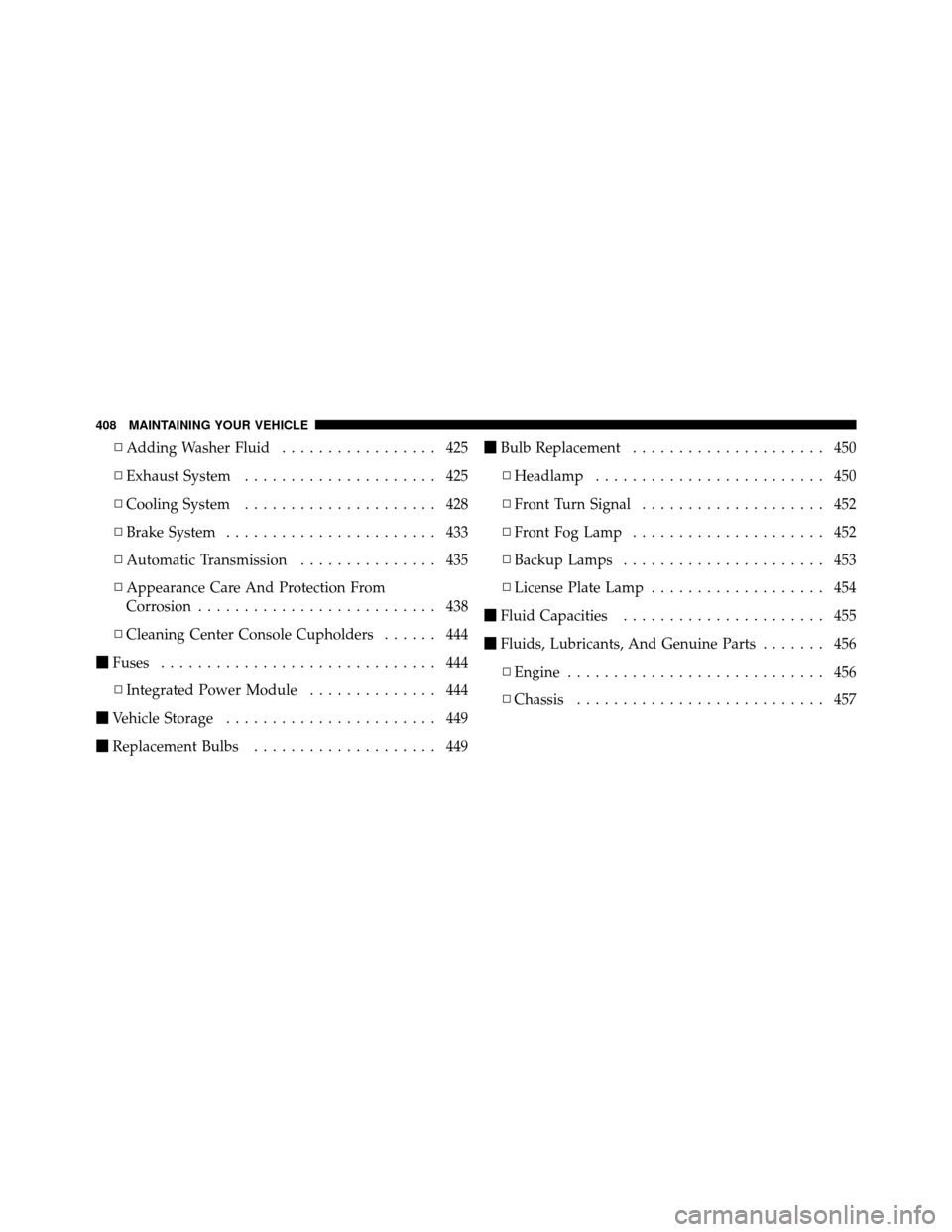Page 91 of 508
Periodic Safety Checks You Should Make Outside
The Vehicle
Tires
Examine tires for excessive tread wear and uneven wear
patterns. Check for stones, nails, glass, or other objects
lodged in the tread or sidewall. Inspect the tread for cuts
and cracks. Inspect sidewalls for cuts, cracks and bulges.
Check the wheel nuts for tightness. Check the tires
(including spare) for proper cold inflation pressure.
Lights
Have someone observe the operation of exterior lights
while you work the controls. Check turn signal and high
beam indicator lights on the instrument panel.
Door Latches
Check for positive closing, latching, and locking.
Fluid Leaks
Check area under vehicle after overnight parking for fuel,
engine coolant, oil, or other fluid leaks. Also, if gasoline
fumes are detected or if fuel, power steering fluid, or
brake fluid leaks are suspected, the cause should be
located and corrected immediately.
2
THINGS TO KNOW BEFORE STARTING YOUR VEHICLE 89
Page 199 of 508

11. Brake Warning LightThis light monitors various brake functions,
including brake fluid level and parking brake
application. If the brake light turns on it may
indicate that the parking brake is applied, that
the brake fluid level is low, or that there is a problem with
the anti-lock brake system.
The dual brake system provides a reserve braking capac-
ity in the event of a failure to a portion of the hydraulic
system. Failure of either half of the dual brake system is
indicated by the Brake Warning Light which will turn on
when the brake fluid level in the master cylinder has
dropped below a specified level.
The light will remain on until the cause is corrected.
NOTE: The light may flash momentarily during sharp
cornering maneuvers which change fluid level condi-
tions. The vehicle should have service performed, and
the brake fluid level checked. If brake failure is indicated, immediate repair is neces-
sary.
WARNING!
Driving a vehicle with the brake light on is danger-
ous. Part of the brake system may have failed. It will
take longer to stop the vehicle. You could have a
collision. Have the vehicle checked immediately.
Vehicles equipped with Anti-Lock brakes (ABS), are also
equipped with Electronic Brake Force Distribution (EBD).
In the event of an EBD failure, the Brake Warning Light
will turn on along with the ABS Light. Immediate repair
to the ABS system is required.
The operation of the Brake Warning Light can be checked
by turning the ignition switch from the OFF position to
the ON/RUN position. The light should illuminate for
approximately three seconds. The light should then turn
4
UNDERSTANDING YOUR INSTRUMENT PANEL 197
Page 292 of 508

▫Gear Ranges ........................ 308
� AutoStick� — If Equipped ............... 315
▫ Operation ......................... 315
▫ General Information .................. 316
� Driving On Slippery Surfaces ............. 316
▫ Acceleration ........................ 316
▫ Traction ........................... 317
� Driving Through Water ................. 317
▫ Flowing/Rising Water ................. 318
▫ Shallow Standing Water ............... 318
� Power Steering ....................... 320
▫ Power Steering Fluid Check ............. 321
� Parking Brake ........................ 322 �
Anti-Lock Brake System (ABS) ............ 324
� Electronic Brake Control System ........... 326
▫ Anti-Lock Brake System (ABS) ........... 327
▫ Traction Control System (TCS) ........... 327
▫ Brake Assist System (BAS) .............. 327
▫ Electronic Stability Control (ESC) ......... 328
▫ ESC Activation/Malfunction Indicator Light
And ESC Off Indicator Light ............ 331
� Tire Safety Information ................. 332
▫ Tire Markings ....................... 332
▫ Tire Identification Number (TIN) ......... 335
▫ Tire Terminology And Definitions ......... 336
▫ Tire Loading And Tire Pressure .......... 337
290 STARTING AND OPERATING
Page 309 of 508

Torque Converter Clutch
A feature designed to improve fuel economy has been
included in the automatic transmission on your vehicle.
A clutch within the torque converter engages automati-
cally at calibrated speeds. This may result in a slightly
different feeling or response during normal operation in
the upper gears. When the vehicle speed drops or during
some accelerations, the clutch automatically disengages.
NOTE:The torque converter clutch will not engage
until the transmission fluid and engine coolant are warm
[usually after 1 to 3 miles (1.6 to 4.8 km) of driving].
Because the engine speed is higher when the torque
converter clutch is not engaged, it may seem as if the
transmission is not shifting into Overdrive when cold.
This is normal. Shifting between the DRIVE and 3 ranges,
when the transmission is sufficiently warm, will demon-
strate that the transmission is able to shift into and out of
Overdrive.
Six-Speed Automatic Transmission (62TE) — If
Equipped
The shift lever position display (located in the instrument
panel cluster) indicates the transmission gear range. You
must press the brake pedal to move the shift lever out of
the PARK position (refer to “Brake/Transmission Shift
Interlock System” in this section). To drive, move the shift
lever from PARK or NEUTRAL to the DRIVE position.
The electronically-controlled transmission provides a
precise shift schedule. The transmission electronics are
self-calibrating; therefore, the first few shifts on a new
vehicle may be somewhat abrupt. This is a normal
condition, and precision shifts will develop within a few
hundred miles (kilometers).
5
STARTING AND OPERATING 307
Page 321 of 508

CAUTION! (Continued)
•Driving through standing water may cause dam-
age to your vehicle’s drivetrain components. Al-
ways inspect your vehicle’s fluids (i.e., engine oil,
transmission, axle, etc.) for signs of contamination
(i.e., fluid that is milky or foamy in appearance)
after driving through standing water. Do not con-
tinue to operate the vehicle if any fluid appears
contaminated, as this may result in further dam-
age. Such damage is not covered by the New
Vehicle Limited Warranty.
•Getting water inside your vehicle’s engine can
cause it to lock up and stall out, and cause serious
internal damage to the engine. Such damage is not
covered by the New Vehicle Limited Warranty.
WARNING!
•Driving through standing water limits your vehi-
cle’s traction capabilities. Do not exceed 5 mph
(8 km/h) when driving through standing water.
•Driving through standing water limits your vehi-
cle’s braking capabilities, which increases stop-
ping distances. Therefore, after driving through
standing water, drive slowly and lightly press on
the brake pedal several times to dry the brakes.
•Getting water inside your vehicle’s engine can
cause it to lock up and stall out, and leave you
stranded.
•Failure to follow these warnings may result in
injuries that are serious or fatal to you, your
passengers, and others around you.
5
STARTING AND OPERATING 319
Page 410 of 508

▫Adding Washer Fluid ................. 425
▫ Exhaust System ..................... 425
▫ Cooling System ..................... 428
▫ Brake System ....................... 433
▫ Automatic Transmission ............... 435
▫ Appearance Care And Protection From
Corrosion .......................... 438
▫ Cleaning Center Console Cupholders ...... 444
� Fuses .............................. 444
▫ Integrated Power Module .............. 444
� Vehicle Storage ....................... 449
� Replacement Bulbs .................... 449 �
Bulb Replacement ..................... 450
▫ Headlamp ......................... 450
▫ Front Turn Signal .................... 452
▫ Front Fog Lamp ..................... 452
▫ Backup Lamps ...................... 453
▫ License Plate Lamp ................... 454
� Fluid Capacities ...................... 455
� Fluids, Lubricants, And Genuine Parts ....... 456
▫ Engine ............................ 456
▫ Chassis ........................... 457
408 MAINTAINING YOUR VEHICLE
Page 411 of 508
ENGINE COMPARTMENT — 2.4L
1 — Engine Coolant Reservoir7 — Air Cleaner Filter
2 — Power Steering Fluid Reservoir 8 — Engine Oil Fill
3 — Automatic Transmission Dipstick 9 — Coolant Pressure Cap
4 — Brake Fluid Reservoir 10 — Engine Oil Dipstick
5 — Power Distribution Center (Fuses) 11 — Washer Fluid Reservoir
6 — Integrated Power Module (Fuses)
7
MAINTAINING YOUR VEHICLE 409
Page 412 of 508
ENGINE COMPARTMENT — 3.6L
1 — Engine Coolant Reservoir5 — Air Cleaner Filter
2 — Power Steering Fluid Reservoir 6 — Engine Oil Dipstick
3 — Brake Fluid Reservoir 7 — Engine Oil Fill
4 — Integrated Power Module (Fuses) 8 — Washer Fluid Reservoir
410 MAINTAINING YOUR VEHICLE